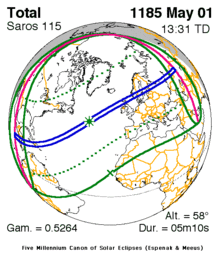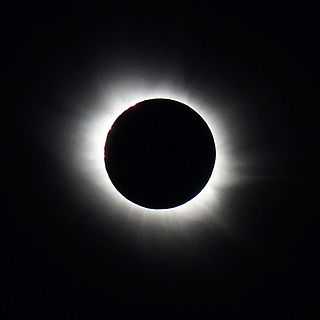Solar eclipse of 1 May 1185

The solar eclipse of 1 May 1185 was a total solar eclipse observed in the territories of Central America, Northern Europe, Eastern Europe, and Kazakhstan. The eclipse is in the Solar Saros 115 series and is number 30. The eclipse shadow on the Earth's surface was at its greatest at 13:18:02 Universal Time. The sun was in Taurus constellation at this time.[1]
Eclipse path
The shadow axis passes between the Earth's center and the north pole, the minimum distance from the center of the Earth to the Moon's shadow cone axis is 3,357 kilometers.[2] The average length of the Moon's shadow is 373,320 kilometers. The distance from the Earth to the Moon on 1 May 1185 is 347,727 kilometers.[2] The apparent diameter of the Moon in 1.0736 times more apparent than the sun.[2] The shadow had a maximum width of 280 kilometers.[3] It began on the west coast of Central America and crossed the Atlantic Ocean in a northeasterly direction. The shadow passed through Nicaragua and the island of Haiti. The maximum duration of the eclipse was in the middle of the North Atlantic at coordinates 46 ° N, 37.2 ° W longitude.[1] The solar eclipse is a long total eclipse that lasted for 5 minutes and 10 seconds.[4] The eclipse magnitude is 1.0736.[1] The eclipse was preceded two weeks earlier by a partial lunar eclipse that happened on April 16.[1]
A partial eclipse came ashore in Scotland, crossed the North Sea and entered Norway. According to astronomer Sheridan Williams there was probably a drop in temperature that happened at the time of the eclipse, which was around 2 pm in Scotland.[5] He says that it was Scotland's fifth longest total eclipse being 4 minutes and 40 seconds there.[5] Williams also notes that it is possible that some adults in Scotland saw two total eclipses in their lifetime, since the previous one was 52 years before.[5]
After passing through Sweden the eclipse touched a part of Finland and covered the northern part of the Baltic Sea at the Gulf of Finland. The eclipse then entered Russia. The eclipse's shadow touched part of St. Petersburg, as well as Novgorod and Rostov. As the eclipse journeyed in a southeasterly direction the shadow passed through Nizhny, Kazan, Ufa and Magnitogorsk. The eclipse shadow started diminishing when it entered in the Central Asia country of Kazakhstan and extinguished totally after about 30 miles before reaching Astana.[6][7][8][9]
In literature
Study of eclipse occurrences can create a precise timetable for historical events that are elusive and could not otherwise be accurately dated.[upper-alpha 1]
The eclipse was mentioned in the Kievan Rus' epic poem Lay of the Host of Igor.[12] It was seen by Prince Igor Svyatoslavich and his army whilst on their campaign against the Polovtsians,[13] and was interpreted as a message from God prophesying trouble.[14] Hence frightening Igor's men who thought it a bad omen.[15][16] According to the Lay, after the eclipse Igor gave a long speech to his retinue to allay their fears before proceeding on his campaign.[17]
The eclipse is mentioned in the 14th-century Laurentian Chronicle with the first detailed description of solar prominences.[10][18][19] They were described as flame-like tongues of live embers:[20][21]
On the first day of the month of May, on the day of the Saint Prophet Jeremiah, on Wednesday, during the evening service, there was a sign in the Sun. It became very dark, even the stars could be seen; it seemed to men as if everything were green, and the Sun became like a crescent of the Moon, from the horns of which a glow similar to that of red-hot charcoals was emanating. It was terrible to see this sign of the Lord.[22][23]
The Melrose Chronicle claims that "stars appeared" at Melrose in Scotland during the eclipse of 1185, but this is doubted by the writer Thomas Cooper who points out that scientific calculations indicate that the eclipse was not total at Melrose.[24]
The Brut y Tywysogion, the Welsh Chronicle of the Princes, says of the solar eclipse of 1 May 1185 Yn y ulwyddyn honno dyw Calan Mei y sumudawd yr heul y lliw; ac y dywat rei uot anei diffyc, which translates as: In that year on the day of the Calends of May the Sun changed its colour; and some said that it was under an eclipse. Bryn Jones believes there was a total solar eclipse across the Scottish Highlands, the Western Isles and Orkney.[25][26]
References
Notes
Citations
- ↑ 1.0 1.1 1.2 1.3 Espenak, Fred (September 19, 2014). "Total Solar Eclipse of 1185 May 01". EclipseWise.com. Fred Espenak. Retrieved April 2, 2015.
- ↑ 2.0 2.1 2.2 "Catalog of Solar Eclipses/The total solar eclipse of May 1, 1185". Russian. 2015. Retrieved April 2, 2015.
- ↑ Espenak, Fred (2015). "Path of the Total Solar Eclipse of 1185 May 01". EclipseWise.com. Fred Espenak. Retrieved April 2, 2015.
- ↑ "The total solar eclipse of May 1, 1185". Catalog of Solar Eclipses. Totality Dive. Retrieved March 30, 2015.
- ↑ 5.0 5.1 5.2 Williams 1996, p. 5.9.
- ↑ "Total Solar Eclipse of 1185 May 01 path". NASA Eclipse Website. NASA. 15 Jan 2015. Retrieved March 30, 2015.
- ↑ Williams 1996, p. 5-9.
- ↑ Svyatskiy D.O. "Astronomical Phenomena in Russian chronicles with scientific and critical perspective" in Svyatskiy D.O. Астрономия Древней Руси (Astronomy in Ancient Russia). Moscow: Panorama, 2007, pp. 45–49 (in Russian).
- ↑ Fred Espenak and Jean Meeus (2006). "NASA Technical Publication TP-2006-214141". FirstGov. Heliophysics Science Division, Code 670 / NASA Goddard Space Flight Center / Greenbelt, MD 20771, USA. Retrieved March 30, 2015.
- ↑ 10.0 10.1 "Solar Eclipses – Past, Present and Future" (PDF). 2014. Retrieved March 30, 2015.
- ↑ Herbermann, Pace & Pallen 1909, p. 335.
- ↑ Sviatoslav Hordynsky; Marko Robert Stech (2004). "Slovo o polku Ihorevi". Encyclopedia of Ukraine. Retrieved 3 April 2015.
- ↑ Terras 1985, p. 425.
- ↑ V. V. Medvedev (1986). Сцена солнечного затмения в "Слове о полку Игореве" [Scene of the Solar Eclipse in the "Lay of the Host of Igor"] (in Russian). feb-web.ru. Retrieved 30 March 2015.
- ↑ Ushinskiĭ 1978, p. 543.
- ↑ "The examination of the text of The Lay of Igor’s Host". History of Russian Literature. WordPress Theme by WPZOOM. 2015. Retrieved March 30, 2015.
- ↑ Nabokov 2009, p. 71.
- ↑ "History of Solar Physics: A Time Line of Great Moments". National Center for Atmospheric Research. National Science Foundation. 2015. Retrieved March 30, 2015.
- ↑ "1185: The first description of solar prominences" (PDF). History of Solar Physics: A Time Line of Great Moments. 2015. Retrieved March 30, 2015.
- ↑ "1185: The first description of solar prominences". Great Moments in the History of Solar Physics. Université de Montréal. 2008. Retrieved March 30, 2015.
- ↑ Sanderson & Harrington 2006, p. 41.
- ↑ Poitevin, Patrick; Edmonds, Joanne (2003). "Solar Eclipse Newsletter" (PDF) 8 (5). Patrick Poitevin. Retrieved March 30, 2015. Original text cited at "Лаврентьевская летопись". Izbornik. Leningrad: USSR Academy of Sciences. 1927. p. 396. Retrieved 30 March 2015.
- ↑ Stephenson 2008, p. 395.
- ↑ Steneck, Nicholas. "Review of 'Robert R. Newton, Medieval Chronicles and the Rotation of the Earth'". Speculum (Cambridge University Press). 49 (April, 1974) (2): 365–368, 367.
- ↑ Jones, Bryn (2008). "The History of Astronomy in Wales". References to eclipses in ancient manuscripts. Bryn Jones. Retrieved March 30, 2015.. The translation is cited there from Jones, Thomas (1955). Brut y Tywysogyon, or, the Chronicle of the Princes: Red Book of Hergest version. Cardiff: University of Wales Press.
- ↑ "Eclipses in ancient Welsh manuscripts". Mesopotamia. AncientWorlds LLC. 2013. Retrieved March 30, 2015.
Sources
- Herbermann, Charles George; Pace, Edward Aloysius; Pallen, Condé Bénoist; Thomas Joseph Shahan, John Joseph Wynne, Andrew Alphonsus MacErlean (1909). The Catholic Encyclopedia: An International Work of Reference on the Constitution, Doctrine, Discipline, and History of the Catholic Church. Robert Appleton Company.
- Nabokov, Vladimir (16 January 2009). The Song of Igor's Campaign. New York, NY: Ardis Publishers, Overlook. ISBN 978-1-4683-0210-3.
- Sanderson, Richard H.; Harrington, Philip S. (2006). The Illustrated Timeline of the Universe: A Crash Course in Words & Pictures. New York: Sterling Publishing Company. ISBN 978-1-4027-3605-6.
- Stephenson, F. Richard (24 March 2008). Historical Eclipses and Earth's Rotation. Cambrdige: Cambridge University Press. ISBN 978-0-521-05633-5.
- Terras, Victor (1985). Handbook of Russian Literature. New Haven: Yale University Press. ISBN 978-0-300-04868-1.
- Ushinskiĭ, Konstantin Dmitrievich (1978). Man as the Object of Education: An Essay in Pedagogical Anthropology (selected Extracts). Progress Publishers.
- Williams, Sheridan (1996). UK Solar Eclipses from Year 1: (an Anthology of 3,000 Years of Solar Eclipses). Leighton Buzzard, England: Clock Tower Press. ISBN 978-1-85142-093-3.
- The total solar eclipse of 1 May 1185 (Russian)
- NASA interactive map of total solar eclipse of 1 May 1185
External links
- NASA Eclipse Website
- Solar eclipse newsletter
- Espenak, Fred. "Total Solar Eclipse of 1185 May 01". eliclipsewise.com.
- NASA Besselian Elements – Total Solar Eclipse of 1185 May 01

